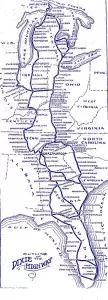Getting Around: Dixie Highway

Follow the path of the Dixie Highway—in places now called Old Dixie Highway—through Palm Beach County:
North of Palm Beach County, Dixie Highway originally ran through Jonathan Dickinson State Park along the Florida East Coast Railway. Beginning at County Line Road and Old Dixie Highway in Tequesta, head south, bearing right onto Old Dixie Highway/FL 811/Alternate A1A.
South of the bridge over the Intracoastal Waterway, a second Old Dixie Highway begins west of the railroad and ends south of Jupiter Lakes Boulevard. This was where it first ran through northern Palm Beach County; remnants of pavement can still be seen along the west side of the tracks from Jupiter to North Palm Beach. After crossing the C-17 Canal, turn right on Richard Road, then left onto Old Dixie Highway west of the tracks.
Bear right at Park Avenue to return to FL 811/Alternate A1A, and continue as it becomes Greenwood Street at 45th Street, West Palm Beach. Turn left on 36th Street, then right onto Poinsettia Avenue/Dixie Highway and continue as it becomes U.S. 1/FL 805. Between Lake Worth and Lantana, Dixie merges with Federal Highway and crosses back to the east side of the railroad.
In south Boynton Beach, turn right onto Old Dixie Highway and continue south to north Delray Beach. Merge with Federal Highway/5th Avenue and continue south. Turn right on SE 10th Street, then left onto Dixie Highway/FL 811 before the railroad tracks. This road becomes Old Dixie Highway/Dixie Highway at Yamato Road in Boca Raton and leads out of Palm Beach County.
A great deal of rock was needed to build roads during the boom era. As a 1914 state geological survey noted, “Companies producing limestone in 1913 included … Palm Beach County of West Palm Beach.” In 1914 Palm Beach County, under the federal Office of Roads, conducted experiments on Dixie Highway two miles south of West Palm Beach to determine the most durable material to use for road construction. The coralline rock mined from Fort Lauderdale was found to be softer and containing more sand than the rock mined at Ojus (Seminole for “lots of” and pronounced “o-juss”), just south of the present border of Broward and Miami-Dade counties. By 1917, in Palm Beach County 150 miles of roads were surfaced with ojus rock.
Greynolds and Monroe
As Greynolds & Monroe, Inc., Manford Burdett Monroe (1874-1945) and Albert Othe Greynolds (1878-1963) created one of the largest local road building companies of the early 20th century. They also operated Greynolds & Monroe Realty Company and developed Monroe Heights in Riviera Beach in 1925, planned as a Danish settlement.
Monroe had arrived from Michigan in 1894 with Joseph Borman, who had a letter of introduction to Elisha N. Dimick; the men started as day laborers for Dimick and others.
Greynolds had farmed in North Dakota before coming to West Palm Beach in the teens. Separately, he developed the Greynolds Highlands (Lantana) and Southland Park (West Palm Beach) subdivisions during the boom era.

